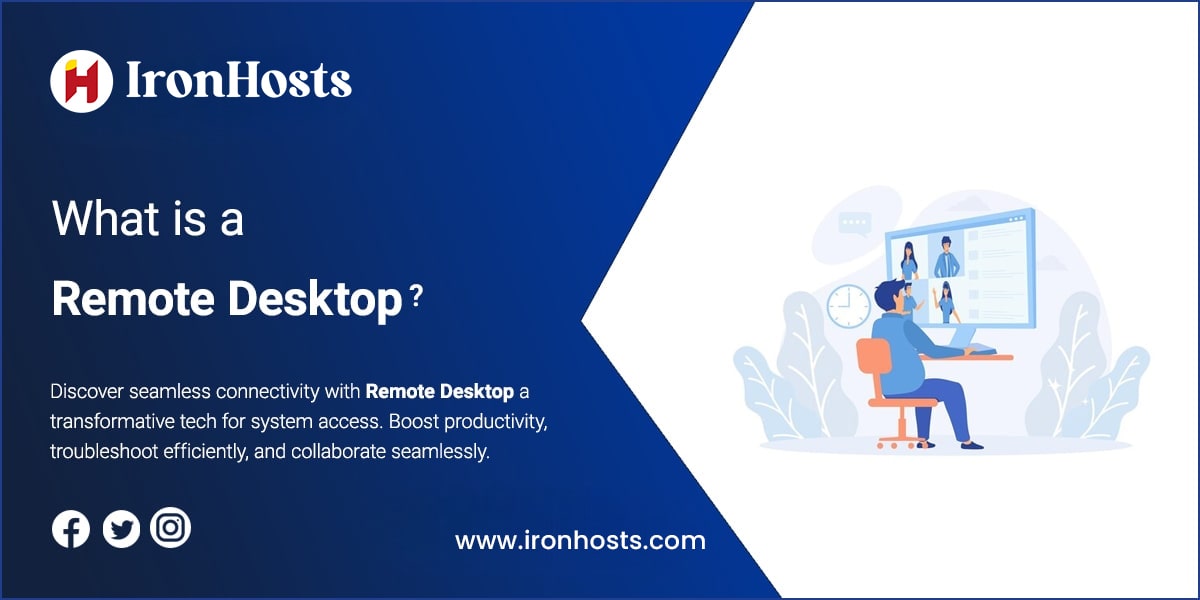Remote Desktop technology is a game-changer, allowing users to access and control a computer or system from virtually anywhere. This innovation transcends physical boundaries and provides a seamless virtual gateway for enhanced productivity. Let’s explore the essence of remote desktop technology and how it transforms our digital interactions.
Understanding the Essence Remote Desktop
A remote desktop is not just a tool it is a life-changing technology that allows users to casually access a computer’s desktop interface, applications, and files. This breakthrough has profound implications, ranging from enhanced productivity to efficient troubleshooting of technical issues.
Key Remote Desktop Features and Functions
Explore key remote desktop features: seamless file transfer, multi-monitor support, secure access, real-time collaboration, and device compatibility for efficient remote work management.
1. Productivity Boost
Experience a surge in productivity as users operate their work remote desktop multiple monitors from different locations, raising an environment conducive to enhanced efficiency and flexibility.
2. Efficient Troubleshooting
IT professionals find a reliable assistant on a remote desktop for diagnosing and resolving issues without the need to be physically present. These streamlines support processes, ensuring swift solutions.
3. Seamless Collaboration
In an era where digital alliance is the standard, RDP becomes a linchpin, facilitating real-time collaboration irrespective of geographical distances. It connects teams, breaking down barriers to effective communication.
4. Technical Mechanisms
Behind the scenes, remote desktops operate using protocols like RDP. These protocols facilitate the transmission of screen images, audio, and input between devices. Robust encryption and authentication measures ensure secure data transmission, safeguarding against unauthorized access.
Choosing the Right Remote Desktop Tool
Selecting the appropriate remote desktop tool and remote access software is essential for maximising productivity and ensuring secure access to your systems. Here are some key considerations to guide your decision:
- Compatibility: Ensure that the remote desktop software is compatible with your operating system and devices. It should support various platforms, including Windows, macOS, Linux, and mobile devices.
- Performance: Look for tools that offer fast connection speeds and minimal latency. A good remote desktop solution should provide a smooth user experience, even over slower internet connections.
- Security Features: Security is paramount when accessing sensitive data remotely. Choose a remote desktop tool that offers robust encryption, multi-factor authentication, and other security measures to protect your information.
- Ease of Use: The interface should be user-friendly, making it easy for users to connect and navigate the tool without extensive training. A straightforward setup process is also beneficial.
- Customer Support: Consider the level of customer support provided. Reliable support can help resolve issues quickly and ensure minimal downtime.
- Cost: Evaluate your budget and compare the pricing plans of different remote desktop solutions. Some tools offer free versions with limited features, while others may have subscription-based models.
- Additional Features: Look for added functionalities that may benefit your workflow, such as file transfer capabilities, session recording, and collaboration tools.
Conclusion
In conclusion, remote desktop technology significantly enhances how we interact with computers, providing unparalleled access and control from virtually anywhere. This capability not only boosts productivity but also enables seamless collaboration, making it an essential tool for modern work environments. As businesses and individuals increasingly rely on remote solutions, understanding and leveraging remote desktop functionality will be crucial for optimizing workflows and maintaining efficiency in our increasingly digital world.
FAQ’s
What is a remote desktop?
A remote desktop is a technology that allows users to connect to and control a computer from a different location via the internet, enabling access to files, applications, and settings as if you were physically present.
What is a remote desktop?
A remote desktop is a technology that allows users to connect to and control a computer from a different location via the internet, enabling access to files, applications, and settings as if you were physically present.
How does remote desktop access work?
Remote desktop access works by using remote desktop software that creates a secure connection between your local device and the remote computer. This connection allows you to view and control the remote desktop environment on your local screen.
What devices can I use to access a remote desktop?
You can access a remote desktop from various devices, including Windows and Mac computers, tablets, and smartphones, as long as you have the appropriate remote desktop software installed.
Is remote desktop secure?
Yes, most remote desktop solutions offer security features such as encryption, multi-factor authentication, and secure connection protocols to protect your data and ensure safe access.
Can I use a remote desktop for work purposes?
Absolutely! Remote desktop technology is widely used for business purposes, allowing employees to access their work computers, collaborate with team members, and provide IT support remotely.
Do I need special software to use a remote desktop?
Yes, you will need remote desktop software installed on both the local device and the remote computer you wish to access. Popular options include Microsoft Remote Desktop, TeamViewer, and AnyDesk.
Can I access my PC remotely while traveling?
Yes, you can access your PC remotely while traveling, as long as you have a reliable internet connection and the necessary remote desktop software installed on your device.
What are the benefits of using a remote desktop?
Benefits include flexibility, convenience, enhanced collaboration, easy IT support, and the ability to work from anywhere, which increases productivity for individuals and teams.

